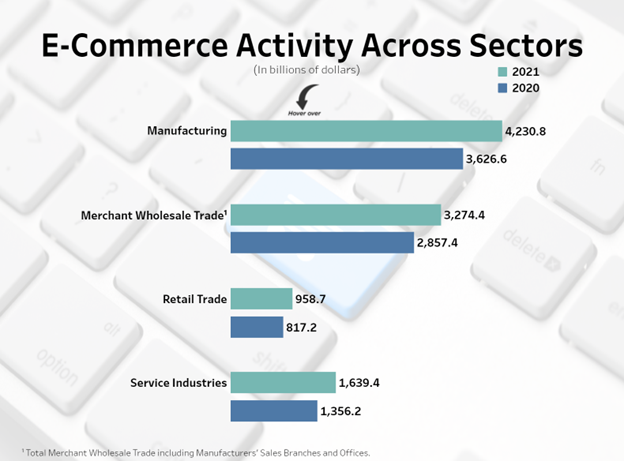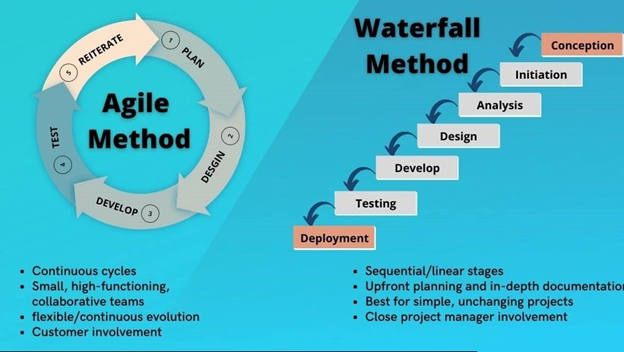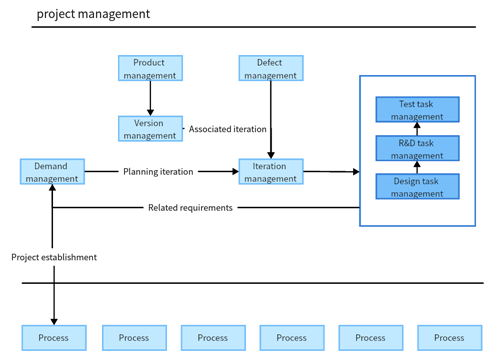eCommerce sales are on the continual rise with a reported compound annual growth rate (CAGR) of 8.99% in the US. In countries such as Turkey, Brazil, and India, eCommerce CAGR exceeds 11%. Such an opportunity means you must ensure your next eCommerce project is successful.
How do you set your online business to run smoothly? By developing and implementing a well-thought-out plan. Whether you’re launching a mobile app or moving to a new domain, every eCommerce project can make or break your business.
This article guides you through the eCommerce project management process.
What Is Project Management in eCommerce?
eCommerce project management encompasses creating, organizing, and implementing an initiative. A plan is developed around objectives, available resources, and other specifications. Project tasks are coordinated, delegated, monitored, and adjusted as needed to reach business goals.
The project manager oversees the entire process. They tackle key metrics and steer the team to deliver on time.
Managing eCommerce requires you to navigate through the world of digital monetization. That doesn’t mean that eCommerce is strictly limited to retail trade. U.S. Census data shows that the most active eCommerce industries are manufacturing and wholesale.

eCommerce manufacturing saw over $4.2 billion of activity in 2021. Image sourced from census.gov
Some Examples of eCommerce Project Management
Starting an eCommerce business is a big project, and there are many stages involved. You might be in the digital startup phase. If not, you might be looking to bring forth a fresh initiative or implement a new platform.
Let’s run through some examples of e-commerce projects for inspiration.
- Website redesign: you want to improve the user experience (UX) for online shoppers.
- Rebrand: updating the imagery for your online channels, including your eCommerce site.
- Mobile app development: creating a streamlined shopping experience for smartphone customers.
- Localization: tailoring your website for various international markets and geographic regions.
- eCommerce platforms: migrating to a new solution for greater capabilities.
- SEO uplift: targeting keywords with content marketing to rise in the search engine rankings.
- Improved security: upgrading infrastructure for better encryption and compliance with data privacy regulations.
- Launching a new product or service: tailoring your eCommerce store to accommodate a new audience or market.
- Integrating new systems: connect business communication tools or customer relationship management (CRM) to your platform.
What Are The Benefits of eCommerce Project Management for Businesses?
Project management has its roots in construction and engineering. Today, it’s an essential component of running a business. Good eCommerce project management requires careful planning and coordinated effort. So what’s the payoff?
The following are common benefits of eCommerce project management for businesses:
- Better organization: Ensure you stay up-to-date on timetables and requirements.
- Greater efficiency: Get the most out of your resources, shifting where you put them as needed.
- Promotes collaboration: Management tools like Kanban boards help everyone know what needs addressing.
- Higher success rates: Aligns every team member to deliver successful projects on time.
- Iterative development: Enables agile development and flexibility to adjust as needed.
- Reduces costs: Spend fewer resources trying to fix problems and eliminate redundant workloads.
- Increased customer satisfaction: Market research and customer feedback empower better results.
What Are The types of Project Management Methodology?
Each organization has its way of doing things. Wherever you fall on the spectrum, there’s a project management methodology that works for you.
Here are some of the most used project management frameworks; they mostly center around fostering effective team collaboration.
Agile
Agile project management emphasizes flexibility and collaboration, and is based on iterations. Each iterative unit is developed in a few weeks or a month, ready to ship upon completion. Agile project management uses sprints to complete each segment.
During development, the team gathers constant customer feedback and adjusts project components accordingly. You can prioritize time, features, or other goals with agile management.
A recent report found that 43% of agile teams focus on customer satisfaction.

A survey found that 35% of agile teams prioritize time to deliver. Image sourced from stateofagile.com
Lean
Lean project management maximizes output and minimizes waste. It aims to get the most bang for your buck. Products are built for customer value.
Lean is also part of the agile methodology family. Continuous improvement is integral to the process. Instead of constant communication, teams are empowered to make decisions and improvements.
Typically, new tasks or mini-projects are based on pull requests from the customer. The pull system is combined with value stream mapping to deliver what the customer needs at the lowest cost possible.
Lean eCommerce project management keeps you agile while dealing with limited resources.
Kanban
Kanban project management is a visualization framework for planning and organizing tasks. It is another agile methodology that uses intuitive workflows to enhance transparency.
A Kanban board breaks tasks into categories like “To Do” and “In Progress.” Team members access the visualization to see who is working on what and which tasks need to be completed, thereby facilitating effective team work.

An image showing some categories you would find on a Kanban board. Free to use image sourced from Unsplash
Scrum
Scrum project management is an agile methodology for organizing teams. Small groups are led by a scrum master who directs collaborative sprint cycles. Everyone meets together daily in 15-minute “scrums”, during which the team is updated on client objectives.
Any team member can share input and expert advice during a scrum meeting. Constant collaboration empowers teams to organize themselves and find the best solutions.
You can conduct market research while simultaneously developing your platform. As customer feedback about eCommerce preferences rolls in, you update your team in daily scrums. Despite shifting goalposts, your agile teams would be able to stay on target and deliver.
Waterfall
Waterfall project management is the traditional way of completing undertakings. You start at the foundation stage and move on to the next sequential step until completion.

An image contrasting agile and waterfall methodologies. Image sourced from LinkedIn.com
The waterfall methodology requires comprehensive planning. It is best suited to large teams with clear responsibilities. One department hands off the project to another one at each stage.
A linear progression generates more predictable results that align with initial plans. In contrast, agile frameworks mean you can end up with very different end-products.
With the waterfall approach, you wouldn’t launch a redesigned website until every item on the checklist has been signed off. Your eCommerce store launches with all the functionality you planned.
How to Manage Your Next eCommerce Project
eCommerce project management should solve problems rather than create new ones. Follow these ten tips to guide your next project to run smoothly.
1) Define Project Goals
Every project starts with a purpose. What are your objectives for adding that new capability to your eCommerce site? Who are you trying to target with a rebrand?
Use a SMART framework when making project goals.
- Specific: What are you hoping to achieve, and how will you do it?
- Measurable: Identify a quantifiable way to assess your progress and completion.
- Achievable: Set realistic goals that your team can attain.
- Relevant: The goals should align with the values and objectives of your eCommerce business.
- Time-bound: Establish deadlines for milestones and deliverables with a final time limit.
2) Identify Product Requirements
What are the final requirements for your ideal product? For example, if you personalize the shopping experience, what’s needed? Do you need API plugins, eCommerce tools, or a completely new platform? Is there back-end development that needs to take place so you can integrate AI?
With an agile framework, you can adjust when new requirements arise. However, it’s best to be as prepared as possible from the beginning.
3) Set a Project Budget
Budget management often depends on the client. In the case of eCommerce project management, you are the client. What can your business afford to invest in bringing forth a new initiative? If money is no object, you can explore all the options available and maintain a flexible framework.
When resources are limited, you need better control of every project component. Work with your subject matter experts to put together an estimate to guide decision-makers.
4) Choose Your Project Management Framework
Everything starts with choosing your management approach. Whether you go with Kanban or Waterfall, all stakeholders need to understand how things will be managed.
You can also opt for hybrid models that combine two or more methodologies. For example, the planning phase could follow the Waterfall method, while during the development of your app, you take an agile, iterative approach.
5) Research and Analyze Competitors
Global eCommerce revenue reached approximately $5.8 trillion in 2023. With consumers buying more frequently online, you can expect the eCommerce solar system to be constantly crowded. Conduct a comprehensive competitor analysis while planning your project management strategy.
Identify your competitors’ strengths and weaknesses. Design your process around maximizing what works and eliminating what fails.
6) Distribute and Delegate
Project managers need to distribute tasks and allocate resources to the right places.
Follow these tips when delegating roles and responsibilities:
- Trust and empower your team by gaining feedback
- Share SMART goals with everyone.
- Prioritize skills and fit when making assignments
- Regularly communicate and give feedback
- Listen to your team and provide them with the right resources
- Trust in team leaders and give them the authority
- Be patient and avoid tight deadlines
- Give credit and recognition
7) Map Out Your Project Workflows
Lay out a visual map of how your project will flow from one stage to the next. If you opt for an agile methodology, this includes showing where iterations branch. A workflow map gives every team member a big-picture view of what’s expected.

Project workflows diagram each stage or iteration. Image sourced from boardmix.com
A workflow diagram will also help you during the planning stages. Look for potential roadblocks or redundancies in the design and confront them.
8) Use eCommerce Project Management Software to Track Progress
eCommerce project management tools streamline communication and collaboration, and enhance accountability and transparency. Research what solutions are available and prioritize those with the features you need.
Must have project management features include:
- Task management and monitoring
- Resource allocation
- Budget management
- Document handling
- Dashboards with real-time reporting
- Workflow visualizations like Gantt charts and Kanban boards
- Time tracking
- Collaboration tools such as discussion threads and team messaging
- Alerts, notifications, and automated email updates
- Calendars and meeting management
9) Track Your Time
Use eCommerce tools that enable intuitive time tracking for team members. Time tracking capabilities help managers keep an eye on how well people are using their time. It also highlights which iterations or tasks are time-intensive and may need additional resources.
Time tracking is also essential for calculating and monitoring your employee utilization rate. How much time is being spent on administrative tasks and meetings? Top managers maximize team member work time for project assignments.
10) Test, Develop, and Continuously Improve
There’s always room for improvement. Test and further develop your eCommerce project during iterations. Monitor for performance after you launch that new website for eCommerce monetization. Track the user experience and gain customer feedback to improve the UX.
eCommerce Project Management is The Way Forward
There’s a lot of money at stake. Digital monetization is essential for businesses like yours. Whether starting or leveling up, every eCommerce project is about the customer. Do your research and find the right methodology for your plans that will foster teamwork.
Follow the management best practices in this guide and enjoy a smoother process and more effective team collaboration. You’ll save yourself from wasting resources and heading back to the drawing board.




